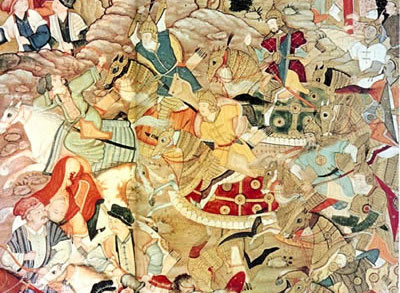
Illustration from History of the Moghuls, a 17th-century Indian text (detail), Gulestan Palace Library, Tehran
When Chinggis Khan died, he did not leave behind an orderly system of succession to the Khanate, nor any principle, other than a personal loyalty to a specific figure, as a basis for the confederation. The confederacy he had designed was based upon personal loyalty from tribal or other kinds of chieftains — it did not transcend to a Mongol nation or Mongol ethnic identity. Thus, each succeeding khan would have to rebuild these personal relationships.
Chinggis had four sons, and before his death he had tapped the third, Ögödei, to be his successor.
Ögödei oversaw the greatest expansion of the Mongol Empire. During his 12-year reign (1229-1241), the Mongols dramatically increased the territories under their control. They moved from Central Asia into Russia in the 1230s and absorbed much Russian territory; they also occupied Georgia and Armenia; and by 1234, they had completely destroyed the Jin dynasty of North China, occupied all of China north of the Yangtze river, and moved into parts of Western Asia, particularly the eastern sections of Persia. [Also see Key Figures in Mongol History: Ögödei]